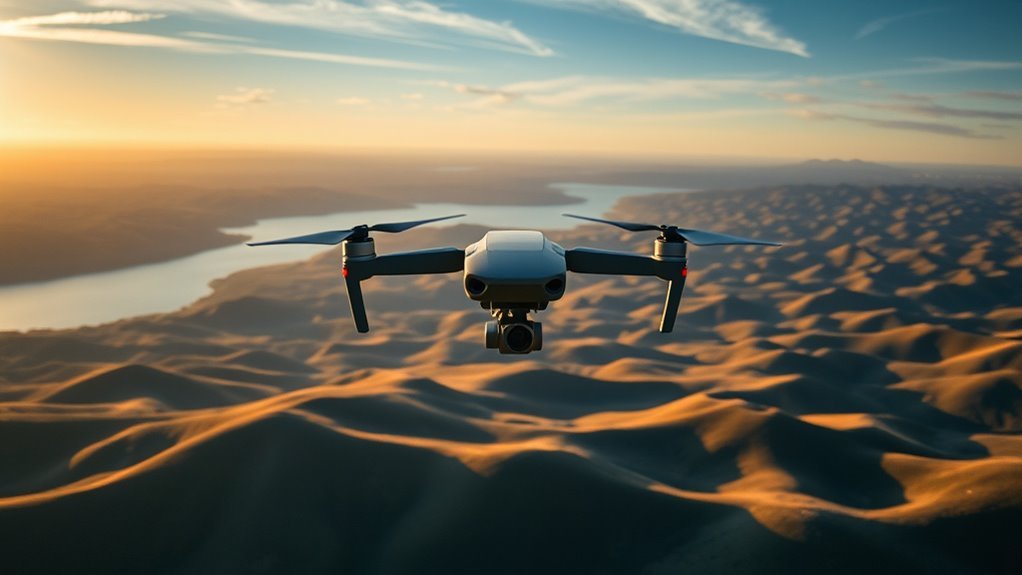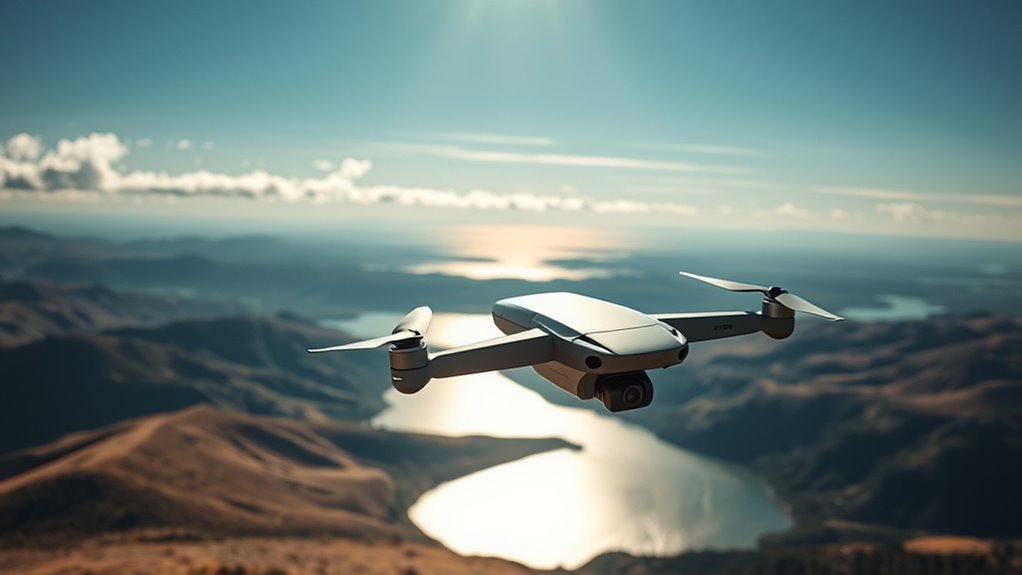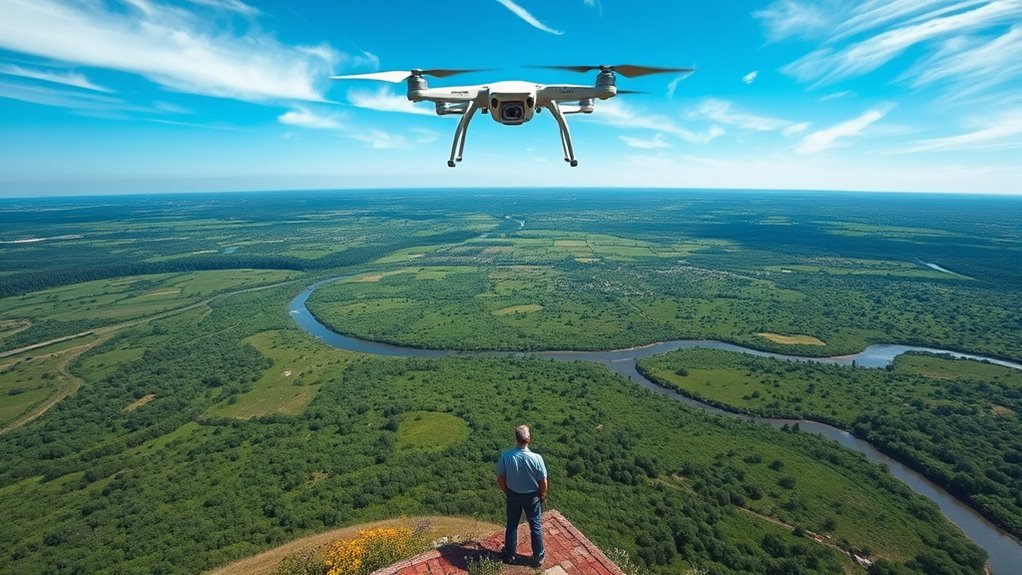Drones typically travel distances ranging from 1 to over 10 kilometers, with capabilities varying by model and battery capacity. Factors like environmental conditions, payload weight, and communication systems greatly affect their range. Consumer drones often top out at 7 kilometers, while commercial drones may exceed this due to better battery efficiency. Understanding these aspects can help you maximize your drone’s operational distance. Learn more about the various influences on drone travel and advancements in technology.
Understanding Drone Range Basics

When considering the range of drones, it’s essential to understand the various factors that influence their travel capabilities. One key aspect is drone communication, which directly impacts range optimization. The quality of the communication link between the drone and its controller determines how far you can effectively operate the drone. Various technologies, like radio frequency and satellite communication, play a role in extending this range. Additionally, environmental variables such as terrain and obstacles can affect signal strength and reliability. By optimizing these communication systems, you can maximize the drone’s operational distance while maintaining control. Understanding these fundamentals will empower you to leverage your drone’s full potential, ensuring you enjoy the freedom of extended aerial exploration. Moreover, factors like battery capacity can significantly influence how far a drone can travel before needing a recharge, as efficient power management can help optimize energy use during flights.
Factors Affecting Drone Travel Distance

Although many factors can influence a drone’s travel distance, key elements include battery life, payload weight, and environmental conditions. To truly harness drone technology for range optimization, you need to understand how these factors interplay.
- Battery life dictates how far you can go before needing a recharge. Battery technology directly influences the operational window, with energy density and power consumption being key factors.
- The weight of your payload markedly impacts energy consumption. Excess weight strains propulsion systems, reducing battery life and operational range.
- Wind conditions can either assist or hinder your flight.
- Temperature affects battery efficiency and overall performance.
- Terrain can create obstacles, limiting your drone’s capabilities.
- Optimized battery usage is essential for maximizing drone range and ensuring longer flights. Proper weight distribution and load balancing are critical for control, which can further enhance flight distance.
Consumer Drones: Typical Range

When considering consumer drones, you’ll find that average flight distances vary greatly among models. Factors such as battery capacity, weight, and signal strength play essential roles in determining their range. Popular consumer models exhibit distinct performance characteristics that impact how far they can travel effectively. Additionally, battery life and power management are crucial for maximizing the flight distance of these drones. Understanding energy efficiency can further enhance the operational range of consumer drones.
Average Flight Distances
Consumer drones typically have a flight range that varies from 1 to 10 kilometers, depending on the model and technology used. With advancements in drone technology and flight navigation, you can explore vast landscapes and capture moments like never before. Here’s what makes this range exciting:
- Aerial adventures await, taking you to places you’ve never been.
- Capture breathtaking views that inspire creativity and freedom.
- Experience the thrill of flying beyond the horizon.
- Stay connected with nature, enjoying a new perspective.
- Release your potential as a photographer or filmmaker.
Understanding average flight distances empowers you to make the most of your drone. Whether for recreation or serious projects, knowing your drone’s capabilities enhances your experience and encourages exploration.
Factors Affecting Range
Numerous factors influence the range of consumer drones, affecting how far you can travel and explore. Battery life is a primary factor; longer-lasting batteries allow for extended flights. Additionally, drone weight impacts its range—heavier drones may struggle against wind resistance. You’ll need to contemplate signal interference issues, such as urban environments or obstructions that disrupt communication between the drone and controller. Using range optimization strategies, like optimizing flight altitude and adjusting frequency settings, can enhance performance. Weather conditions, particularly wind and rain, also play a critical role in determining how far you can navigate. Understanding these elements helps you maximize your drone’s capabilities, ensuring you get the freedom to explore as far as possible.
Popular Consumer Models
Drones have become increasingly popular for both recreational and professional use, and understanding their typical range is essential for maximizing your flying experience. Popular consumer models vary greatly in range due to unique drone features and specifications. Generally, you can expect ranges from 1 to 7 kilometers, depending on the model and conditions.
- Capture breathtaking aerial views
- Explore vast landscapes with ease
- Experience the thrill of flight freedom
- Engage in fun, creative photography
- Share your adventures with the world
When making range comparisons, consider how battery life, signal strength, and environmental factors impact your drone’s performance. Understanding these aspects guarantees you make the most of every flight, allowing you to explore uncharted territories.
Commercial Drones: Extended Capabilities
When evaluating commercial drones, it’s essential to take into account flight range limitations and the factors influencing battery life. Your operational needs will dictate the importance of these aspects, as they directly affect mission planning and efficiency. Understanding how these elements interplay will enable you to optimize drone performance for various applications. For instance, the DJI Mavic 3 Enterprise boasts a flight time of up to 45 minutes, which can significantly enhance operational capabilities. The Amazon MK30 excels in battery efficiency, often exceeding 30 minutes of flight time, making it a strong contender for delivery operations.
Flight Range Limitations
In the domain of commercial drones, understanding flight range limitations is essential for maximizing operational efficiency. While technological advancements have greatly enhanced capabilities, various factors can restrict your drone’s range. Flight regulations often impose boundaries, affecting how far you can operate.
Consider these emotional aspects of flight range limitations:
- The thrill of exploration cut short
- Missed opportunities for capturing stunning visuals
- The frustration of adhering to regulations
- The empowerment of overcoming obstacles
- The dream of limitless skies
Recognizing these limitations allows you to optimize flight plans and align with regulations, ensuring you operate within safe parameters while still seeking freedom in your aerial endeavors.
Battery Life Factors
While battery life is a crucial factor in determining a commercial drone’s operational range, several elements influence how efficiently that battery is utilized. Battery technology is continually evolving, impacting energy density and overall performance. Higher energy efficiency in motors and propellers can greatly extend flight times. Additionally, payload weight plays an essential role; heavier loads drain batteries faster, reducing range. Environmental conditions, such as wind and temperature, also affect battery performance—drones may consume more power to maintain stability in adverse weather. By optimizing these factors, you can maximize your drone’s capabilities and achieve greater flight distances. Understanding these elements empowers you to make informed decisions for your aerial operations, enhancing freedom and flexibility in your drone applications.
Military Drones: Unmatched Range
Military drones possess unparalleled range capabilities, often exceeding thousands of miles. This extensive reach enhances military capabilities, enabling strategic operations without compromising safety. The advancements in drone technology have transformed how nations approach warfare and surveillance.
- Imagine the power of real-time data from distant territories.
- Consider the implications for national security and global stability.
- Reflect on the autonomy these drones provide to operators.
- Think about the ethical dilemmas surrounding their use.
- Envision a future where freedom is defended from afar. The integration of advanced navigation and control systems ensures precision in executing missions while minimizing risks. Moreover, the proactive vulnerability identification capabilities of these drones can enhance operational effectiveness by mitigating potential threats before they arise.
These factors not only demonstrate the technical prowess of military drones but also evoke a sense of responsibility. As they redefine engagement, it’s crucial to weigh the implications of such technology on our shared values of freedom and security.
Battery Life and Its Impact on Travel
The impressive range of military drones is greatly influenced by battery life, which directly affects their operational capabilities. Battery efficiency plays an essential role; it determines how long a drone can stay airborne, impacting mission success. When you’re managing energy, optimizing flight patterns and payload can markedly extend travel distance. Advanced energy management systems monitor power consumption and adjust performance accordingly, ensuring drones can operate longer without sacrificing functionality. As signal attenuation occurs through various materials, understanding these factors allows you to maximize your drone’s potential, ensuring you achieve greater operational range while enjoying the freedom that drones provide in various missions and tasks. Additionally, precision spraying technology can help extend the operational reach of drones by optimizing resource use during flights.
Environmental Influences on Range
Although various factors can influence a drone’s range, environmental conditions play an essential role in determining how far it can travel. Weather conditions, such as wind speed, temperature, and precipitation, can greatly affect your drone’s performance. If you want to maximize your drone’s freedom, understanding these influences is imperative.
Environmental factors significantly impact a drone’s range, making it essential to understand weather conditions for optimal performance.
- Strong winds can cause instability, draining battery technology faster.
- High temperatures may lead to overheating, reducing efficiency.
- Rain or snow can impair electronics, risking your flight.
- Humidity can affect battery performance and flight time.
- Poor visibility can limit your operational range, impacting your ability to navigate.
- Understanding advanced stabilization technology can help mitigate some of the effects of adverse weather conditions on flight performance.
Legal Restrictions on Drone Flight Distance
Environmental conditions aren’t the only factors impacting how far drones can fly; legal restrictions also play a vital role. You must navigate complex legal frameworks that govern airspace regulations, which dictate specific operational zones and permissible flight corridors. Obtaining drone permits often comes with stipulations that restrict distance to enhance safety protocols. Governmental oversight guarantees compliance, primarily driven by privacy concerns and the need to protect individuals from intrusive surveillance. These regulations can limit your operational range considerably, depending on the area you’re flying in. Understanding these constraints is essential for maximizing your drone’s capabilities while remaining compliant with the law. Additionally, awareness of restricted zones is crucial to prevent potential penalties and ensure safety during operations. Fundamentally, freedom in drone flying is often balanced against legal obligations you must heed.
Future Trends in Drone Range Technology
As technology evolves, advancements in battery life and communication systems are set to considerably extend drone range capabilities. You’re witnessing a revolution driven by drone innovations and emerging technologies that promise to redefine aerial freedom. Future developments aim to enhance not just distance but reliability and efficiency in drone operations.
Advancements in battery life and communication are revolutionizing drone capabilities, enhancing distance, reliability, and operational efficiency.
- Longer flight times mean more expansive exploration. Advanced algorithms will enable drones to optimize their routes, maximizing their flight durations.
- Improved connectivity enhances data transmission and real-time feedback.
- Advanced navigation systems reduce the risk of accidents.
- Increased payload capacity allows for diverse applications.
- Enhanced battery technology minimizes downtime.
- European brands’ focus on sustainable materials not only supports eco-friendly practices but also contributes to the longevity of drone technology.
These innovations not only empower you with unprecedented operational scope but also guarantee safety and efficiency, paving the way for a future where your drones can truly roam free.
Frequently Asked Questions
Can Drones Travel Beyond Visual Line of Sight?
Think of a bird soaring freely; drones can achieve similar heights with long-range capabilities. However, regulatory restrictions often limit their flight beyond visual line of sight, balancing innovation with safety concerns in the skies above.
What Is the Maximum Altitude Drones Can Fly?
Drones typically face altitude limits set by drone regulations, often capping at 400 feet above ground level. However, specific permissions can allow higher flights, offering you more freedom to explore aerial capabilities within legal boundaries.
How Do Weather Conditions Affect Drone Travel?
Weather conditions greatly impact drone travel. Wind resistance can hinder stability and control, while temperature effects may influence battery performance. Understanding these factors helps you plan flights for ideal efficiency and safety in varying environments.
Are There Specific Laws for Flying Drones in Cities?
Yes, there are specific city regulations governing drone operations. You’ll often need drone permits to fly legally, ensuring compliance with local laws. Always check the requirements in your area to avoid fines or restrictions.
How Often Should Drone Firmware Be Updated for Optimal Range?
For range enhancement, you should regularly check for firmware updates. Typically, updating every few months or whenever a new version is released guarantees your drone performs at its best and maintains peak functionality.

